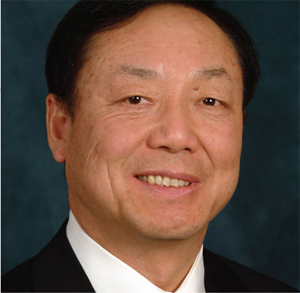Lin Yang Enables Hi-Res Free TV for Speeding Cars
Lin Yang's SuperTV technology lets cars on US freeways receive terrestrial digital TV broadcasts in 1080i resolution.
Lin Yang’s SuperTV technology lets cars on US freeways receive terrestrial digital TV broadcasts in 1080i resolution.
“Receiver sensitivity is the key problem that we focused on,” said Yang, Legend Silicon’s co-founder, chief technology officer and inventor of single-carrier maximal-ratio combining (MRC) diversity technology. “Sensitivity performance is especially critical for urban vehicular TV reception in single-carrier mode.”
SuperTV technology allows product manufacturers to boost picture reception quality by adding more antennas, turning the problem into an issue of cost-effectiveness rather than an insurmountable technological hurdle. So SuperTV essentially solves the diversity and mobile reception issues inherent in the US legacy Advanced Television Systems Committee (ATSC) Digital Terrestrial Broadcast (Free-to-Air) market. The lack of diversity or mobile reception solutions limited the delivery of advertiser-supported TV broadcasts to fixed, stationary DTV with roof-top antennas. SuperTV paves the way for car TV and mobile TV reception of legacy over-the-air (OTA) ATSC television broadcasts throughout the US.
“We believe SuperTV will usher in a new era for OTA TV broadcasting industry in the U.S. where mostly indoor-viewing of legacy ATSC TV will be expanded to car TVs, tablet PCs and other mobile devices,” said Raj Karamchedu, Legend Silicon’s COO and marketing head. “Another game changer will be SuperTV reception technology co-existing with the reception of the emerging ATSC Mobile standard whose target markets are smart phones with screen sizes smaller than tablet PCs.”
US legacy ATSC broadcasts use single-carrier technology with an 8-VSB modulation scheme. Other countries use multi-carrier DTV standards like China’s DTMB standard (which uses a combination of single-carrier and multi-carrier technologies), or Europe’s DVB-T and Japan’s ISDB-T standards in which mobile TV reception isn’t an issue. Until SuperTV no commercially feasible solution was available in the US for mobile reception of legacy ATSC television signals because smooth DTV reception in a mobile environment requires not only more than one antenna at the receiver, but often three or four antennas as is commonly seen with car TVs in Japan. This requires a receiver to effectively combine separate signals at the antennas for optimal performance without reception blind spots using a technique known as maximal-ratio combining (MRC).
Legend Silicon’s patent-pending MRC diversity technology for single-carrier terrestrial TV broadcasts, invented by Lin Yang, is at the core of SuperTV technolog. It had first been developed to allow high-performance car DTV reception of single-carrier OTA broadcasts under China’s DTMB standard and is already in mass production in Legend’s dual-mode terrestrial-cable DTV demodulator for national CTTB standard broadcasts there. Legend is also a co-inventor of China’s GB20600-2006, the national standard for DTV broadcast (also known as CTTB or the DTMB standard).
Yang is currently leading developing of a Field Programmable Gate Array (FPGA)-based demonstration system for live car TV reception of legacy ATSC broadcasts for the US market. This demonstration platform is expected to be available in the first quarter of 2012.
“Legend Silicon’s SuperTV technology is quite impressive,” says Thomas Adam of Hirschmann Car Communications. “With single-carrier reception in car TV it is possible to drive more than 160 km/h (100 mph) without any disturbances in the picture. Even under bridges we’ve experienced single-carrier reception without any disturbances in picture quality.”
Stuttgart-based Hirschmann Car Communications develops car TV and car radio boxes built into premium German cars. The China models of these cars are all equipped with Legend Silicon -based Hirschmann car TVs.
Legend Silicon is Fremont, CA-based a fabless chipmaker that develops technology and application specific semiconductor products (ASSP) for digital broadcasting and broadband transmission. Its products are designed for use in TV sets (high definition and standard definition), car TVs, set top boxes, portable media players (PMPs), video-enabled cell phones and wireless network interface adapters for PCs. It has branches in Beijing and Shanghai.
Lin Yang is an ASIC design expert with over 20 years of specialized experience in digital communication, digital signal processing, voice and image processing, and cell-based technology. He holds over 50 patents relating to GB, TDS-OFDM, and DTV receiver, and has managed several generations of the industry/market leading GB DTV receiver chip designs. He has published over 20 original papers on DTV related fields.
Prior to co-founding Legend Silicon, Yang was Director of the Wireless Design Services Group for Cadence Design Systems, where he led ASIC development teams for a wide variety of multimedia and telecommunications applications. These applications included digital television systems, 3G cellular systems, a satellite wireless communication handset, and a watch-based pager. Yang was also a professor of the electrical engineering department of Tsinghua University between 2001 and 2006.
Yang received his PhD in electrical engineering from UC Berkeley, a masters in electronics from Tsinghua University, and a bachelors in electronics from Fudan University.

Lin Yang's SuperTV technology will let Americans watch terrestrial digital TV broadcasts on the go at freeway speeds.

